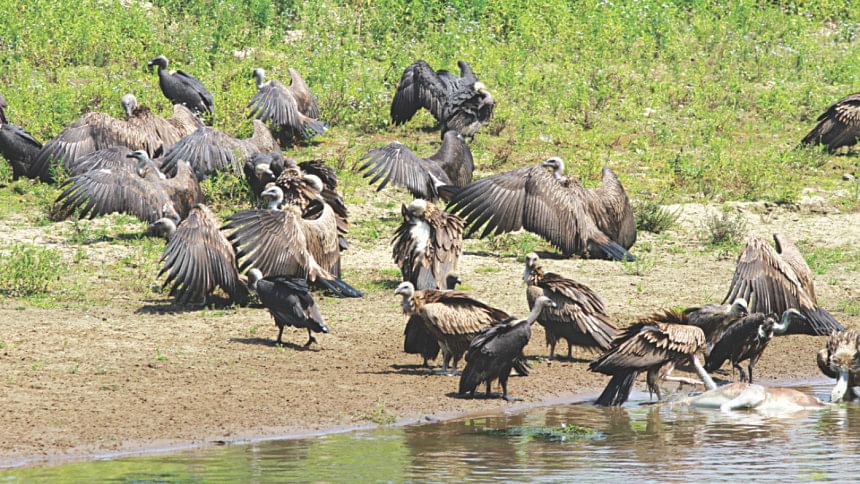Nature Quest: For the love of vultures

The torrents had just stopped and sunlight filtered through the bright green canopy above, forming columns of light spiraling down to the moist forest floor.
The humidity was stifling and the forest eerily silent, as if held under a spell; every living being waiting for something to happen. Not even a leaf stirred; the birds had fallen quiet. We were surrounded by huge trees. The mighty garjans shot up towards the zenith, stood solemnly like silent sentinels of the forest. The only sound came from our footsteps sloshing through the water of the recent downpour. Leeches devoured our blood.
In front of me were four men carrying a dead cow tied upside down to bamboo poles, its head dangling side to side. The whole scene resembled that of a mystical, sacrificial ceremony to a powerful being. We turned a corner and came into a small opening inside the forest. There stood a platform, four feet tall with a bamboo top. And on that platform lay splinters of bone and skull of another dead cow.
The feeling of being watched was all too real. Looking up, I saw massive figures with long necks peering down from top of garjan trees.
The creatures were white-rumped vultures and the dead cow is part of a last ditch effort to save these magnificent animals from becoming extinct from Bangladesh and the rest of the world. All vulture species of the world are in trouble and rapidly disappearing.
There are now less than 500 white-rumped vultures left in Bangladesh. The White-rumped Vulture Conservation Project run by the International Union for Conservation of Nature, Bangladesh along with the Forest Department is trying desperately to save the last remaining vultures.
The primary reason the vultures are disappearing is the use of anti-inflammatory drugs diclofenac and ketoprofen in cattle. Vultures are scavengers and when a vulture feeds on a cattle treated with diclofenac it dies of renal failure. The harmful drug diclofenac has already been banned by the government and a National Vulture Committee has been formed showing the government's commitment towards conservation of this species.
The project also works with local communities and has established Vulture Safe Zones in Khulna and Sylhet where no harmful drugs are allowed ensuring safe food and protection of vulture habitat.
The bamboo platform is a Vulture Feeding Station in the heart of the Vulture Safe Zone at Rema-Kalenga Wildlife Sanctuary. The primary objective of the station is to provide a helping hand to the vultures and the hatchlings by providing them with food without any harmful drugs during the breeding season. The station is run by the community-based Vulture Conservation Team (VCT). Whenever a cow dies naturally in the Vulture Safe Zone, the VCT acquires the cow, which is then tested for harmful drugs and only after ensuring that the cow is safe, it is provided to the vultures.
As we carefully hoisted the cow on to the feeding station, the forest was finally coming to life in a frenzy of activities; the giant Malayan squirrels searching for food and pig-tailed macaques leaping from one tree to another. The babblers and drongos started their rackets and the orioles and magpie-robins sang their songs. The vultures took off and soared high above the forest, leaving those dedicated for their survival with a warm feeling inside and a stronger pledge to save the last of our remaining vultures.
International Vulture Awareness Day is on September 5.
Sakib Ahmed is working in IUCN Bangladesh as Wildlife Researcher.

 For all latest news, follow The Daily Star's Google News channel.
For all latest news, follow The Daily Star's Google News channel. 



Comments